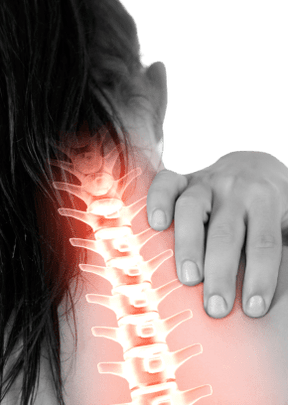Osteochondrosis of the cervical spine accounts for about a quarter of all cases of osteochondrosis. He is the "youngest" and often affects people under the age of 30. The disease develops gradually, progressing slowly but steadily. In the initial stage of development of cervical osteochondrosis, it can mostly be asymptomatic, which becomes an accidental finding during the X-ray examination.

Causes of osteochondrosis
The disease manifests itself as dull aching pains in the chest, under the shoulder blades, in the shoulder area, numbness and the appearance of "goose bumps" in the chest, stiffness of movement. Often, girdle pain, accompanied by angina pectoris, may cause unpleasant painful sensations in the stomach and difficulty breathing. Occasionally there is short-term acute pain.
Causes of destruction of the spinal discs and compression of the nerve endings of the spinal cord can be scoliosis acquired in adolescence, inactive lifestyle, obesity, the same type of load on the spine and regular prolonged sitting.
Osteochondrosis of the cervical spine: symptoms
The most important, first and most common symptom of osteochondrosis of the cervical spine is pain. It intensifies when bending or turning the head. Depending on the localization of the pathological focus, pain may be inflicted on the nape of the neck, under the shoulder blade, or in the arm.
Depending on the localization of the pathological focus, pain may be inflicted on the nape of the neck, under the shoulder blade, or in the arm.
It can be constant, painful. It can occur from time to time, but as the disease progresses, it increasingly worries a person. The pain is also sharp, shooting. This is a symptom of worsening cervical osteochondrosis, which can manifest after hypothermia of the body.
Head movements are usually difficult. This is due to the constant tension of the muscles in the area of the collar and neck. Crunching is often heard when leaning forward or turning the head.
In the later stages of cervical osteochondrosis, a person cannot hold his head for long. Sometimes he is unable to turn or tilt it without experiencing severe pain. The patient tries to support his head with his hands or tries to take a comfortable position to ease his suffering.
Vertebral artery syndrome

This group of symptoms occurs due to compression of the vertebral artery by a displaced intervertebral disc, overgrown with cartilage tissue or tense muscles. The syndrome is a complex of symptoms, including cervical migraine, impaired consciousness and high blood pressure.
Cervical migraine is a headache that results from reduced blood flow and lack of oxygen in the tissues. The pain is often unilateral. It hurts, first of all, the nape of the neck. Possible radiation to ear, eye or forehead.
Sometimes hearing loss occurs and the ears start ringing. Possible visual impairment. It doubles in the eyes, before the eyes "fly". The scalp can become so painful that it cannot be touched. Headaches with osteochondrosis of the cervical spine are often accompanied by nausea and vomiting.
A common symptom of cervical osteochondrosis and compression of the vertebral artery is an increase in blood pressure. But osteochondrosis of the cervical spine and hypertension are not always interrelated. It should be borne in mind that in old age many people experience an increase in pressure.
Only after studying the history of cervical osteochondrosis, the doctor can determine whether hypertension is a complication of the disease. If there is a history of recurrent attacks of arterial hypertension, accompanied by palpitations and fear of death, this is most likely one of the symptoms of spinal artery compression. If the increase in pressure occurred gradually and no frequent hypertensive crises were observed, most likely, the patient has hypertension, which is not associated with osteochondrosis.
Impairment of consciousness occurs when there is not enough blood supply to the brain. There is drowsiness, dizziness, decreased speed of reaction to external stimuli. There is a short-term loss of consciousness.
Rehabilitation after stroke
What are the most dangerous symptoms of cervical osteochondrosis? Undoubtedly, it is a spinal stroke - the death of a part of the spinal cord due to the complete absence of blood flow in the constricted veins. This always leads to disability, causing paresis and paralysis. Fortunately, strokes are rare.
Cardiac syndrome
Heart pain is one of the symptoms of worsening osteochondrosis of the cervical spine. It is caused by tightening of the posterior roots of the fourth spinal nerve. In fact, heart pain could be attributed to radicular syndrome. But this symptom is specific and is therefore isolated as a separate syndrome.
Heart pain with osteochondrosis can mimic angina pectoris or myocardial infarction. But when the patient seeks medical help, the competent doctor can immediately, only on the basis of the patient's symptoms and complaints, rule out heart disease.
- First, the presence of other symptoms of osteochondrosis of the cervical spine in a patient will already lead specialists to the idea that the cause of heart pain could be problems with the spine;
- Second, the pain is not strong and sharp, as in myocardial infarction, and is not accompanied by fear of death. It is not associated with physical activity, unlike an attack of angina pectoris;
- Third, such pain is quite long and after taking nitroglycerin does not pass and does not even subside;
- Fourth, the pain is increased by turning or tilting the head, which is not observed in "real" heart disease.
Radicular syndrome
Radicular syndrome combines those signs of cervical osteochondrosis that develop as a result of compression of the spinal nerve roots. Depending on the level at which the contraction occurred, different symptoms of intervertebral osteochondrosis of the cervical spine may develop.
Root compression at the level of the first or second segment leads to numbness of the occipital skin or pain in the occipital region.
Pinching the root of the third spinal nerve leads to numbness of the tongue and skin behind the ear. If the motor fibers tighten, it becomes difficult for a person to chew food and he has a feeling of an enlarged tongue.
Root compression at the level of the fourth segment of the spinal cord causes pain in the heart and collarbone, hiccups and migraine of the pharynx. A foreign body is felt in the throat, it is difficult to swallow food. There may be a sore throat that mimics a sore throat. But the differential diagnosis of cervical osteochondrosis and tonsillitis is not difficult at all. Inflammation of the pharyngeal tonsil is always accompanied by hyperthermia, while in osteochondrosis of the cervical spine, the body temperature does not rise.
Symptoms of cervical osteochondrosis
The most common symptom of pinching of the root of the fifth spinal nerve is impaired mobility of the shoulder muscles. It is difficult for the patient to raise his hand and take it aside.
Pinching the roots of the sixth segment most often causes pain in the shoulder blade and forearm. It becomes difficult for the patient to bend and rotate the forearm.
The seventh pair of spinal nerves primarily innervates the hand, index finger, and middle finger. When tightened, there is a disturbance in the mobility of these parts of the body, numbness or pain occurs.
Pinching at the level of the eighth segment makes it difficult to bend and lengthen the ring finger and little finger. Pain and sensor damage may also occur. However, these manifestations can already be attributed to the symptoms of osteochondrosis of the cervicothoracic spine, because the roots of the eighth spinal nerve are located between the seventh cervical and first thoracic vertebrae.
What is the risk of cervical osteochondrosis? First of all by its complications. The appearance of intervertebral hernias can lead to compression of the spinal cord and, as a result, the development of paresis and paralysis. When the first symptoms of cervical osteochondrosis appear, treatment should already begin. Properly chosen therapy will slow the progression of the disease, improve the quality of life of the patient and avoid the development of complications of cervical osteochondrosis.

























